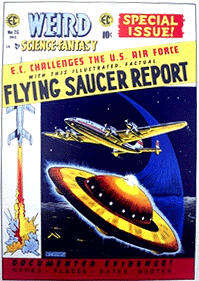

Four Color Saucers!
As with the movies, alien visitors of all shapes and dispositions have been a common theme in comics for years. In addition to the usual interplanetary hordes featured in everything from Strange Tales to Superman, a number of interesting comics have been devoted specifically to the actual UFO phenomenon. Comics fans will not be surprised to hear that the legendary EC Comics entered the field first and produced some of the best saucer stories ever.
EC's staffers had more than a passing interest in the topic; company . founder William Gaines once recalled that "Al [Feldstein] and I were about 75 percent convinced that there must be such things as flying saucers...Just the whole idea that the Air Force was suppressing something was delightful, anyway. So even if it weren't true, we wished it were." This saucer-friendly viewpoint is reflected in several classic EC tales, beginning with "Flying Saucer Invasion" in the July 1950 issue of Weird Science (#13). This story, co-created by Gaines and Feldstein, retells the first few years of the saucer boom with EC's characteristic wit. Various governmental stuffed shirts dismiss the saucer reports as mass hysteria, drunkenness and weather balloons and the military closes its investigation - just a few months before the main saucer armada arrives. A few years later came a sequel of sorts, "EC Confidential" (Weird Science #21, Sept.-Oct. 19S3), in which an EC corporate higher-up demands to know how the earlier story, with its unforgettable cover of a saucer streaking over the Capitol Building, could have so neatly predicted the Washington sightings of 1952. Answer: the EC writers and artists were actually friendly Venusians, attempting to warn Earth about the dangers of a Martian invasion!
The most memorable UFO comic ever, though, has to be EC's Weird Science-Fantasy #26 of December 1954. In contrast to the light-hearted, sardonic tone of the earlier saucer stories, this issue was a serious treatment of actual UFO sightings based on the writings of Donald Keyhoe, a respected investigator of the era. Keyhoe spent an entire day with the EC staff, who constructed a series of accounts featuring actual names, dates and quotes from Keyhoe's files. The book received a good deal of national publicity and became a sellout. These ECs are the cornerstone of any saucer comics collection. Unfortunately, they're priced accordingly. Weird Science #13 is about $180 in fine condition; number 21 goes for $100 or so, and Weird Science-Fantasy#26 sells for around $70. (The ECs have been reprinted in various formats by Russ Cochran, and a well-stocked comics shop should be able to help you obtain them.)
With the mid-1960s flaps, interest ran high enough to generate several series. Dell's Flying Saucers ran for five issues between 1967 and 1969. The stories were fictional, but oddly dolled up as actual case histories. Unfortunately, the art was indifferently executed by second-stringers like Sam Glanzman and Frank Springer. The Invaders, a short-lived spin-off of the Quinn Martin TV series, lasted for four issues from Gold Key in 1967-68. The stories are simplistic, but succeed in capturing something of the show's sense of brooding paranoia; photo covers and "pin-ups" make them essential for "Invaders" collectors. Another Gold Key series, UFO Flying Saucers, produced 13 issues released sporadically between 1968 and 1977. The beautiful painted covers Gold Key was known for make these worth picking up for a few bucks each.
-Bruce Lanier Wright
MAIN ARTICLE: INVADERS FROM ELSEWHERE
SIDEBARS
Photo by Bruce Lanier Wright
Strange Magazine contributing editor Bruce Lanier Wright is a pop-culture historian and avid, if puzzled, fortean living in Austin, Texas.
